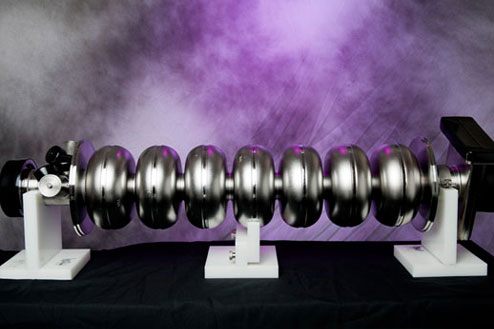
On April 8, 1911, Heike Kamerlingh Onnes cooled a sample of mercury to just a few degrees above absolute zero and was astonished to find that his sample lost all resistance to the flow of electricity. That very same day in his lab at Leiden University in the Netherlands, Onnes found that gold, too, became superconducting at cryogenic temperatures.
A little more than 75 years after Onnes discovered superconductivity, construction began on what would become the first large-scale superconducting particle accelerator: Jefferson Lab’s CEBAF accelerator. The superconducting components of the accelerator would not be made of mercury or gold, but a relatively rare metal called niobium.
Niobium superconducting radiofrequency accelerator cavities are the crucial components in CEBAF that harness the energy that it pumps into its beam of electrons. Because they’re superconducting, the SRF cavities allow energy to flow through them with very little resistance. Therefore, most of the energy pumped into SRF components goes into accelerating particles. In non-SRF accelerators, much of this energy is lost to heat.
To learn more about CEBAF, the first large-scale SRF particle accelerator, read this short article: Fifteen Years of Beam On Target
SRF Leadership
Jefferson Lab is a world leader in SRF technologies. Lab staff study and advance the materials used in superconducting cavities, continuously improving them to make possible future particle accelerators. Jefferson Lab is one of only a few places in the world where such cavities can be designed, fabricated, processed and tested.
The lab has processed and assembled well over 500 SRF cavities since its founding. In addition, more modular SRF accelerator units, called cryomodules, and different cryomodule designs have been constructed here than any place else in the world.
The lab also has more than 15 years of experience operating two accelerators, the CEBAF accelerator and the Free-Electron Laser accelerator. All told, Jefferson Lab operators account for more than 35 percent of the world’s integrated operational SRF experience.
100 Years of Superconductivity
Several scientific publications have produced articles or special editions to honor the centennial anniversary of superconductivity. Here’s a list of some of those special editions.
Physics Today: The discovery of superconductivity
Science: Superconductivity's Smorgasbord of Insights: A Movable Feast
Physics World: free special superconductivity issue
Institute of Physics 100 articles for 100 years of superconductivity (available free through December 2011)

